Seismology and Earthquakes
Stress vs Strain Relationships
When rocks (or other solid materials) are subjected to differential (directional)
stress, they respond by deforming. Tensional stress stretches
materials, compressional stress squeezes them, and shear stress
causes slippage and translation. The term used to describe the
deformation of materials is strain, which is defined as the change
in size or shape (or both) of a solid as a result of stress. Uniform
stress causes a solid to change size uniformly in all directions, whereas
differential stress results in a change in shape and perhaps in size.
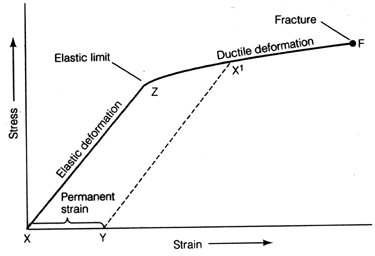 When
a solid is subjected to increasing stress, it passes through three stages
of deformation in succession:
When
a solid is subjected to increasing stress, it passes through three stages
of deformation in succession:
1. Elastic deformation is a reversible (non permanent) change
in volume of shape. When the stress is removed, the solid returns
to its original shape and size. Sir Robert Hooke (1635-1703) demonstrated
that a plot of stress vs strain for material behaving in an elastic fashion
is a straight line, as shown in the figure to the right. There exists,
however, a limiting stress, known as the elastic limit (point Z),
beyond which a solid suffers permanent deformation and does not return
to its original shape.
2. Ductile deformation is an irreversible change in size and/or
shape in solids that have been stressed beyond the elastic limit.
If the stress is removed at point X', the material will partially return
to its original shape -- a permanent strain, equal to XY, has been introduced
into the material.
3. Fracture occurs in a solid when the limits of both elastic
and ductile deformation are exceeded. A material is said to be brittle
when it deforms by fracture (breaking). Different materials have
different stress-strain relationships. Elastic materials such as
rubber are dominated by the elastic portion of the curve. Materials
such as wood have some elastic properties and virtually no region of ductile
character. Common rocks exhibit elastic and ductile behavior before
ultimately breaking by brittle fracture.
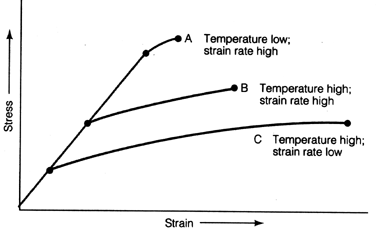 The way
in which any material responds to stress is significantly influenced by
two factors: 1) temperature and 2) the strain rate. As illustrated in the
figure to the right, if strain rates are high and temperatures are low,
rocks have a significant range of elastic behavior, little or no ductile
behavior, and fracture at relatively low amounts of strain. Thus,
a cold rock at the surface (as in curve A) when struck by a quick blow
with a large hammer will break. This kind of behavior is typical
of shallow crustal rocks rocks. In contrast, rocks in the asthenosphere
are hot, strain rates are slow (several cm/yr), and consequently they display
behavior more like curve C, dominated by ductile (plastic) deformation.
Rocks in the deep crust and mantle lithosphere behave more like curve B.
The way
in which any material responds to stress is significantly influenced by
two factors: 1) temperature and 2) the strain rate. As illustrated in the
figure to the right, if strain rates are high and temperatures are low,
rocks have a significant range of elastic behavior, little or no ductile
behavior, and fracture at relatively low amounts of strain. Thus,
a cold rock at the surface (as in curve A) when struck by a quick blow
with a large hammer will break. This kind of behavior is typical
of shallow crustal rocks rocks. In contrast, rocks in the asthenosphere
are hot, strain rates are slow (several cm/yr), and consequently they display
behavior more like curve C, dominated by ductile (plastic) deformation.
Rocks in the deep crust and mantle lithosphere behave more like curve B.
Earthquakes
Earthquakes are the result of rocks being strained beyond their limit of
ductile deformation, and consequently breaking. Breaks in rocks are
known as faults -- planar surfaces along which movement occurs.
Faults are classified on the basis of the relative sense of movement into
three main categories:
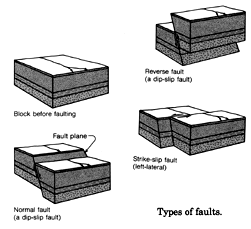 A. Normal Faults.
These faults result from tensional stress and produce movement in which
one block moves down relative to the other block in such a fashion as to
extend the length of the two blocks together.
A. Normal Faults.
These faults result from tensional stress and produce movement in which
one block moves down relative to the other block in such a fashion as to
extend the length of the two blocks together.
B. Reverse (Thrust) Faults. These faults result from compressional
stress and produce movement in which one block moves down relative to the
other block in such a fashion as to compress the length of the two blocks
together.
C. Strike-Slip Faults. These faults have little or no vertical
displacement. Instead, the two blocks on either side of the fault
move past one another in a horizontal fashion. Strike-slip faults
are further described as being either left lateral or right lateral.
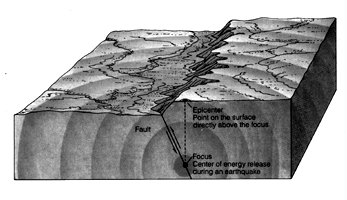 When
rocks fail by brittle fracture, energy is released at the point on the
fault plane where breakage occurs. This location, usually at some
depth below the surface is known as the focus of the earthquake.
From this point, seismic waves radiate outward in all directions.
An important concept in locating earthquakes is the epicenter
-- the point on the Earth's surface directly above the focus.
When
rocks fail by brittle fracture, energy is released at the point on the
fault plane where breakage occurs. This location, usually at some
depth below the surface is known as the focus of the earthquake.
From this point, seismic waves radiate outward in all directions.
An important concept in locating earthquakes is the epicenter
-- the point on the Earth's surface directly above the focus.
Seismic are elastic disturbances that travel through the interior of
the planet or along its surface. THey fall into two families:
A. Body Waves These waves travel outward from the focus
in all directions and have the capacity to travel all the way through the
earth. There are two types of body waves:
-
Compressional (P) Waves travel through and elastically deform materials
by a change in volume, but not shape. A P wave consists of alternating
pulses of compression and expansion acting in the direction of wave travel.
Sound waves are an example of compression waves. P waves have the
greatest velocity of all seismic waves, with 6 km/sec being typical of
velocity in the upper crust. Owing to their higher velocity, P waves
will be the first to arrive at, and be detected by, a seismometer.
For this reason they are often called primary waves.
-
Shear (S) Waves travel through and elastically deform solids by
a change in shape. Shear waves consist of an alternating series of
sidewise movement with each particle in the wave being displaced perpendicular
to the direction of travel. Because gases and liquids do not have
any elasticity to return to their original shape after deformation, shear
waves can be transmitted only by solids. A typical velocity for an S wave
in the upper crust is 3.5 km/sec. Consequently S waves arrive at
a seismometer some time after the first arrival of the P waves, hence "S"
also stands for "secondary" waves.
B. Surface Waves are those which travel on the surface. They
may be produced by movement of the fault which reaches the surface, or
by P and S waves when they reach to surface. Surface waves travel
the slowest of all types of seismic waves.
A schematic example of a seismogram illustrating arrival times is shown
below:
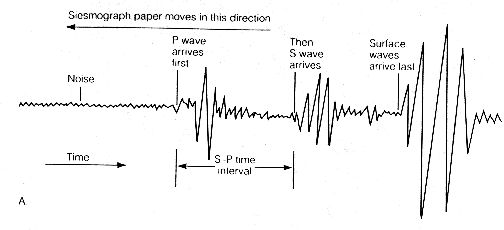
Determination of Earthquake Epicenters
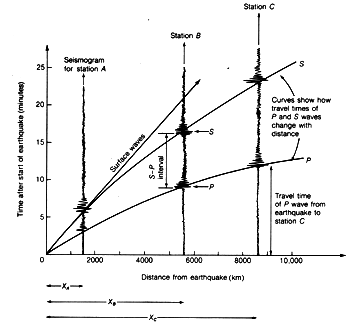 Epicenters of earthquakes
can be located by utilizing the difference in velocity between the P and
the S waves (much like estimating the distance to a lightning strike by
counting the time between seeing the strike (light waves) and hearing the
thunder (sound waves). By knowing the velocities of P and S waves
in typical rocks, diagrams such at the one shown to the left can be used
to determine the distance from the epicenter to the seismograph.
Data from three or more seismometers are needed to precisely locate the
earthquake.
Epicenters of earthquakes
can be located by utilizing the difference in velocity between the P and
the S waves (much like estimating the distance to a lightning strike by
counting the time between seeing the strike (light waves) and hearing the
thunder (sound waves). By knowing the velocities of P and S waves
in typical rocks, diagrams such at the one shown to the left can be used
to determine the distance from the epicenter to the seismograph.
Data from three or more seismometers are needed to precisely locate the
earthquake.
Earthquake Magnitudes
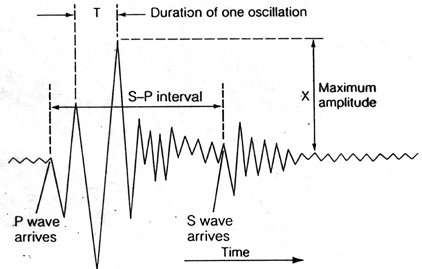 Earthquakes result
in a release of energy stored by the rocks as strain during deformation.
Seismologists have adopted the Richter magnitude scale (named after
the seismologist who developed it following the 1906 San Francisco earthquake)
to estimate the energy released during an earthquake. Determination
of an earthquake's Richter magnitude is accomplished by measuring 1) the
maximum amplitude of the P-wave displacement as recorded by a seismometer
(X in the figure to the left), 2) the duration (in seconds) of one oscillation
(T), and 3) the distance from the earthquake to the seismometer.
The formula employed is:
Earthquakes result
in a release of energy stored by the rocks as strain during deformation.
Seismologists have adopted the Richter magnitude scale (named after
the seismologist who developed it following the 1906 San Francisco earthquake)
to estimate the energy released during an earthquake. Determination
of an earthquake's Richter magnitude is accomplished by measuring 1) the
maximum amplitude of the P-wave displacement as recorded by a seismometer
(X in the figure to the left), 2) the duration (in seconds) of one oscillation
(T), and 3) the distance from the earthquake to the seismometer.
The formula employed is:
Richter Magnitude, M = log X/T + Y
Y is a correction factor that depends on the distance of the
seismometer from the epicenter, and accounts for the fact that the energy
of the seismic waves decreases as the waves travel outward from their source.
It is important to understand that the Richter scale is a log scale, and
consequently each unit increase in Richter magnitude corresponds to an
order of magnitude increase in the amount of energy released. For
example, a Richter Magnitude (M) 4 earthquake releases 10 times as much
energy as an M3 earthquake, and an M6 earthquake releases 1000 times the
energy as an M3.
|
Richter
|
Number
|
Characteristic Effects of
|
|
Magnitude
|
per Year
|
Shocks in Populated Areas
|
| <3.4 |
800,000 |
Recorded only by seismographs |
| 3.5 to 4.2 |
30,000
|
Felt by some people who are indoors |
| 4.3 to 4.8 |
4,800
|
Felt by many people, windows rattle |
| 4.9 to 5.4 |
1,400
|
Felt by everyone; dishes break, doors swing |
| 5.5 to 6.1 |
500
|
Slight building damage; plaster cracks, bricks fall |
| 6.2 to 6.9 |
100
|
Much building damage, chimneys fall, houses move on foundations |
| 7.0 to 7.3 |
15
|
Serious damage, bridges twisted, walls fractured, many buildings collapse |
| 7.4 to 7.9 |
4
|
Great damage; most buildings collapse |
| >8.0 |
one every |
Total damage; waves seen on ground surface, |
|
5 - 10 years |
objects thrown into the air |
Exploring the Interior of the Earth with Seismic Waves
Natural and man-made earthquakes can be used to determine both the structure
and physical properties of the interior of the planet. The fundamental
concept is that seismic waves may be reflected and/or refracted as they
pass through different layers or regions of the Earth.
Seismic Reflection
This technique has been effectively used (especially by the petroleum
industry) to image relatively shallow structures and rock layers such as
on the floor of the oceans or in the upper layers of the continental crust.
Seismic P waves (sound waves) are generated by a pneumatic device (much
like a balloon bursting). These seismic waves penetrate water, unconsolidated
sediment (e.g., mud) and relatively shallow rock layers and are reflected
off the different layers back to the surface where they are recorded by
sensitive listening devices knows as geophones. The resulting images
of the shallow subsurface provide information on folds, faults and other
structures such as domes as shown in the reflection image below.
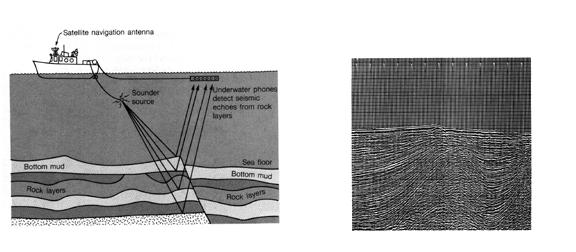
Seismic Refraction
As seismic waves pass through rocks of different densities and with
different seismic velocities, they are refracted, or bent.
By studying seismic waves that pass through the deep interior of the planet,
we can determine not only physical properties such as density, but can
also "map" major boundaries such as the the between the crust and lithosphere
(the MOHO).
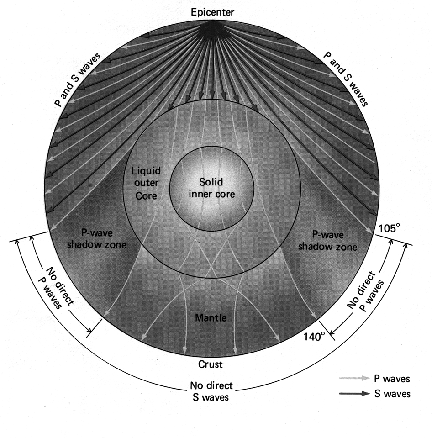 In addition,
we can utilize the different properties of seismic waves to determine
the structure and physical properties of the deep interior, including the
core. The figure to the right illustrates how we know the outer core is
liquid. Since S waves cannot be transmitted by liquids, seismic waves
passing through the core have their S-wave component blocked. This
results in a "shadow zone" of approximately 106o where no S
waves are recorded. Furthermore, refraction and reflection of P waves
at the inner core - outer core boundary serve to locate this boundary,
and confirm the the inner core is indeed solid. See your textbook
for more details on this.
In addition,
we can utilize the different properties of seismic waves to determine
the structure and physical properties of the deep interior, including the
core. The figure to the right illustrates how we know the outer core is
liquid. Since S waves cannot be transmitted by liquids, seismic waves
passing through the core have their S-wave component blocked. This
results in a "shadow zone" of approximately 106o where no S
waves are recorded. Furthermore, refraction and reflection of P waves
at the inner core - outer core boundary serve to locate this boundary,
and confirm the the inner core is indeed solid. See your textbook
for more details on this.
 This page created by Jack Rice with Netscape Navigator Gold
This page created by Jack Rice with Netscape Navigator Gold
 When
a solid is subjected to increasing stress, it passes through three stages
of deformation in succession:
When
a solid is subjected to increasing stress, it passes through three stages
of deformation in succession:
 The way
in which any material responds to stress is significantly influenced by
two factors: 1) temperature and 2) the strain rate. As illustrated in the
figure to the right, if strain rates are high and temperatures are low,
rocks have a significant range of elastic behavior, little or no ductile
behavior, and fracture at relatively low amounts of strain. Thus,
a cold rock at the surface (as in curve A) when struck by a quick blow
with a large hammer will break. This kind of behavior is typical
of shallow crustal rocks rocks. In contrast, rocks in the asthenosphere
are hot, strain rates are slow (several cm/yr), and consequently they display
behavior more like curve C, dominated by ductile (plastic) deformation.
Rocks in the deep crust and mantle lithosphere behave more like curve B.
The way
in which any material responds to stress is significantly influenced by
two factors: 1) temperature and 2) the strain rate. As illustrated in the
figure to the right, if strain rates are high and temperatures are low,
rocks have a significant range of elastic behavior, little or no ductile
behavior, and fracture at relatively low amounts of strain. Thus,
a cold rock at the surface (as in curve A) when struck by a quick blow
with a large hammer will break. This kind of behavior is typical
of shallow crustal rocks rocks. In contrast, rocks in the asthenosphere
are hot, strain rates are slow (several cm/yr), and consequently they display
behavior more like curve C, dominated by ductile (plastic) deformation.
Rocks in the deep crust and mantle lithosphere behave more like curve B.
 A. Normal Faults.
These faults result from tensional stress and produce movement in which
one block moves down relative to the other block in such a fashion as to
extend the length of the two blocks together.
A. Normal Faults.
These faults result from tensional stress and produce movement in which
one block moves down relative to the other block in such a fashion as to
extend the length of the two blocks together.
 When
rocks fail by brittle fracture, energy is released at the point on the
fault plane where breakage occurs. This location, usually at some
depth below the surface is known as the focus of the earthquake.
From this point, seismic waves radiate outward in all directions.
An important concept in locating earthquakes is the epicenter
-- the point on the Earth's surface directly above the focus.
When
rocks fail by brittle fracture, energy is released at the point on the
fault plane where breakage occurs. This location, usually at some
depth below the surface is known as the focus of the earthquake.
From this point, seismic waves radiate outward in all directions.
An important concept in locating earthquakes is the epicenter
-- the point on the Earth's surface directly above the focus.

 Epicenters of earthquakes
can be located by utilizing the difference in velocity between the P and
the S waves (much like estimating the distance to a lightning strike by
counting the time between seeing the strike (light waves) and hearing the
thunder (sound waves). By knowing the velocities of P and S waves
in typical rocks, diagrams such at the one shown to the left can be used
to determine the distance from the epicenter to the seismograph.
Data from three or more seismometers are needed to precisely locate the
earthquake.
Epicenters of earthquakes
can be located by utilizing the difference in velocity between the P and
the S waves (much like estimating the distance to a lightning strike by
counting the time between seeing the strike (light waves) and hearing the
thunder (sound waves). By knowing the velocities of P and S waves
in typical rocks, diagrams such at the one shown to the left can be used
to determine the distance from the epicenter to the seismograph.
Data from three or more seismometers are needed to precisely locate the
earthquake.
 Earthquakes result
in a release of energy stored by the rocks as strain during deformation.
Seismologists have adopted the Richter magnitude scale (named after
the seismologist who developed it following the 1906 San Francisco earthquake)
to estimate the energy released during an earthquake. Determination
of an earthquake's Richter magnitude is accomplished by measuring 1) the
maximum amplitude of the P-wave displacement as recorded by a seismometer
(X in the figure to the left), 2) the duration (in seconds) of one oscillation
(T), and 3) the distance from the earthquake to the seismometer.
The formula employed is:
Earthquakes result
in a release of energy stored by the rocks as strain during deformation.
Seismologists have adopted the Richter magnitude scale (named after
the seismologist who developed it following the 1906 San Francisco earthquake)
to estimate the energy released during an earthquake. Determination
of an earthquake's Richter magnitude is accomplished by measuring 1) the
maximum amplitude of the P-wave displacement as recorded by a seismometer
(X in the figure to the left), 2) the duration (in seconds) of one oscillation
(T), and 3) the distance from the earthquake to the seismometer.
The formula employed is:

